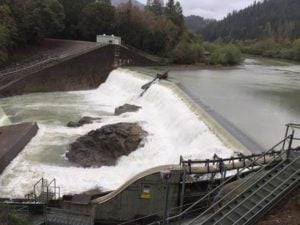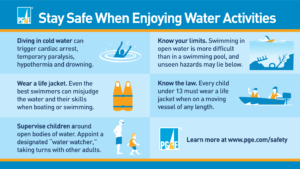
Eel River overflowing at Van Arsedale Reservoir, April, 2017, from PG&E.
MENDOCINO CO., 5/07/17 — Now that temperatures are getting hotter, rivers all over the North Coast are beginning to swell with run-off from this past wet winter and resultant snowpack. Currently, PG&E’s Lake Pillsbury and Van Arsdale Reservoir are both currently spilling, but the overflow is expected to stop by mid-May. The wet winter and spring mean that current river flows in the Eel, the Russian, and other regional waterways are unusually high — and while it may seem the perfect time to head to the river, here’s a few safety tips to keep in mind.
High flows can mean increased rapids and swift water, which can make for more challenging boating conditions and create more risks for everyone enjoying the water, be it in a boat, whitewater rafting, swimming, or having fun on shore. With prolonged snowpack, water temperatures can remain frigid despite warm days, and with rapidly melting snow, conditions can change rapidly. According to California Division of Boating and Waterways (DBW) statistics, boating fatalities can double in years with precipitation levels like this one.

Info from DBW and PG&E.
In a press release, DBW’s Deputy Director Lynn Sadler said, “To increase the chances of survival in cold, high water, it is critical that water enthusiasts exercise extra caution and awareness. We urge boaters and water enthusiasts to study the outdoor conditions and stay safe.”
DBW and PG&E have shared a few safety tips as you enjoy the current currents —the following is from a joint press release concerning physical safety in the water, including boating and rafting tips and life jacket info. For more water safety information, including boating laws, please visit www.BoatCalifornia.com.
Have fun and stay safe out there! More tips are below the video.
Know the Water
—Sudden immersion in cold water can stimulate the “gasp reflex,” causing an involuntary inhalation of air or water. It can even trigger cardiac arrest, temporary paralysis, hypothermia and drowning. When faced with swift water, even the strongest swimmers may be easily overwhelmed.
—Cold water entering the ear canal can cause vertigo and disorientation. This may confuse swimmers, causing them to venture deeper into the water.
— Cold water also reduces body heat 25 to 30 times faster than air does at the same temperature, and causes impairment that can lead to fatalities.
—Recreating in PG&E canals and flumes is strictly prohibited. Stay out of these water conveyances, which are very dangerous due to slippery sides and fast moving water.
Know your Limits
—Swimming in open water is more difficult than in a swimming pool – people tire more quickly and can get into trouble.
—Many unseen obstacles can be lurking below the water’s surface – this is especially the case with this year’s high runoff following years of drought. Drought-stricken forests and storm-driven landslides have filled rivers with submerged trees and rocks. Swift water can make these obstacles even more treacherous. Guided trips for inexperienced paddlers are recommended.
Wear a Life Jacket
—Conditions change quickly in open water and even the best swimmers can misjudge the water and their skills when boating or swimming. Wearing a properly fitted U.S. Coast Guard-approved life jacketcan increase survival time.
—A life jacket can also provide some thermal protection against the onset of cold water shock and keep you afloat until someone else can rescue you.
—Need a life jacket? Many locations across the state allow you to borrow a lifejacket for the day or weekend. Learn more at www.BoatCalifornia.com.
Whitewater Rafting and Paddling
Most California rivers are fed by the mountain snowpack, so they are cold year around. Even on warm, sunny days, rafters and paddlers must be prepared to deal with the water temperatures. The dangers increase as water temperatures decrease below normal body temperature (98.6 degrees F).
DBW offers whitewater enthusiasts informative safety videos online. The dangers of high, fast and cold water safety.
Parental Supervision
Actively supervise children in and around open bodies of water, giving them your undivided attention. Do not assume that someone is watching them. Appoint a designated “water watcher,” taking turns with other adults.
Teach children that swimming in open water is not the same as swimming in a pool: they need to be aware of uneven surfaces, river currents, ocean undertow and changing weather.





